
Small businesses around the world have been especially vulnerable to this crisis. Image sourced from Bloomberg News.
Today marked the beginning of the second application period for loans under the Paycheck Protection Program. After the initial $350 billion in support was depleted in less than a week, US government approved an additional round of funding and is presently considering a third. These loans are intended to support small businesses that have suffered due to restrictions put in place to combat the current pandemic.
Some note that program’s guidelines have made it possible for additional businesses to be overlooked despite the fact that they are small and in dire need of assistance. One such group are US subsidiaries of foreign companies. How the US decides to aid companies in this class—and how foreign countries decide to treat subsidiaries of US companies—will have effects on local communities as well as diplomatic relations.
Government-backed PPP loans are intended to help small businesses who are suffering due to national restrictions brought on by Covid-19. Payments are deferred for 6 months with the total not being due for two years. They’re forgivable, even up to the maximum amount—$10 million. According the SBA website, those eligible for this assistance must meet the following guidelines:
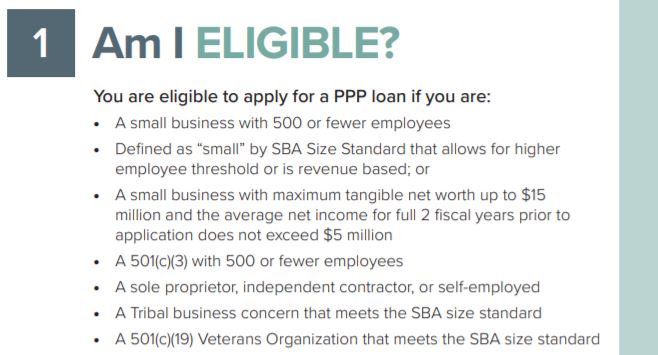
What does this mean for small businesses that happen to be subsidiaries of foreign companies?
Owners of companies fitting this description can breathe a sigh of relief—at least for the time being. Per the SBA’s guidelines on what constitutes a “small business concern,” subsidiaries and affiliates of foreign companies are generally are allowed to request assistance, as long as they meet the size requirements listed above. Companies are only excluded from this kind of assistance when they are a joint venture with the foreign entity having more than 49% ownership.
The US federal government’s decision to allow foreign owned subsidiaries to apply for aid, assuming they meet requirements, has benefits on the local level as well. States like Illinois, Texas, and Virginia have seen a rise in foreign direct investment. Additionally, foreign companies that expand to the US hire American workers. According to the TradePost USA, 7.4 million Americans were employed by foreign-owned companies in 2017, up 2% from the year prior. International business doesn’t only happen in high-level corporate settings. Sometimes it’s the business next door that employs your neighbor or family member.
Is the same courtesy extended elsewhere?
The answer to this is yes, in some cases. Unsurprisingly, the US has signed tax-treaties with a long list of countries around the world. Each agreement has its own unique details, meaning varying treatment for US subsidiaries.

French Finance Minister Bruno Le Maire arrives at the Palace Elysée. Image sourced from EPA/Christophe Petit Tesson.
France, for example, is home to a number of US companies. It’s longstanding agreements have made it an attractive destination for American firms. In line with its socialist traditions, this country has been on the more generous side of small business assistance. Under France’s assistance program, referred to as fonds de solidarité, qualifying businesses were initially eligible for up to 1,500 a month in assistance. Recently, that number has been expanded to between 2,000, and 5,000 for extreme circumstances. In contrast to the one-time loans in the US, the French Ministry of Finance has approved these monthly payments for as along as the country is on lockdown. Companies are eligible for this assistance so long as they meet size requirements and can prove that they either 1) were forced to close due to government restrictions, or 2) suffered a decline in sales due to the pandemic. This requirement is slightly more selective than in the US, where companies do not need to prove they had closed or missed out on earnings in order to qualify for a loan.
Only companies with their financial headquarters located in tax havens are expressly prevented from accessing this aid. Eligibility requirements for the fonds de solidarité focus on size and capital, not corporate citizenship. This is to say that subsidiaries of American companies based in the country are eligible for the same assistance as French companies.
Small businesses are the bedrock of all major economies, whether they are homegrown or foreign affiliated. Closures due to the current pandemic have caused great economic hardship, especially for small and midsize enterprises. Government officials in the US and around the world are implementing programs to keep them afloat.
Stay tuned for further analysis of other countries’ responses to small businesses in need of assistance.
Is your company a small business affected by the current economic slowdown? Business owners and executives reviewing their current strategies may benefit from our self-assessment tool. Initially designed for international projects, this pdf makes sure all aspects of the business are covered. Download it for free at the bottom of our Services page.
Upon request, free online consultations will be available to executives who use the self-assessment and might still need some help. The economic impact of this pandemic is global. We contribute our expertise in international business to make a difference because we are all in this together.

If you follow trends in eco-conscious living, odds are you’re familiar with the concept of zero waste.
More or less self-explanatory, it describes a lifestyle that’s beneficial to the planet by creating as little waste as possible.
Naturally, participation in zero waste varies by level of intensity. Some keep a modest compost bin next to the sink. On the more extreme end, there are those who can fit an entire year’s worth of refuse into one jar.
Much of the rhetoric in this movement focuses on using, reusing, and repurposing items as opposed to letting them end up in a landfill. At the same time, there is a growing market of companies offering products to consumers under the ‘sustainability’ tag. A number of these items are aimed at replacing single use or plastic products.
Despite being well-intentioned, the problem with these brands is that their products are often price exclusionary. Not everyone can afford the water canteens made from repurposed plastic bottles or the brushes made from recycled paper. This makes sustainable living seem more akin to luxury living. It also overlooks the inexpensive—and cost-free—habits we can all adopt to contribute to the planet’s well-being.
Luckily, there are brands breaking the oh-so-expensive mold. One such brand is Chicago-based Zefiro. It’s founder, Carley Pulford, says she got introduced to the world of sustainability by accident.

“I was house sitting for a friend in Vancouver,” Pulford says, “and she asked me to head over to their local refill store to get some more detergent.” Refill stores aren’t as common in the US, but the basic principle is that they sell household necessities in bulk. Customers bring their own jars and pay for what they need by weight. Thus, the need for unnecessary or single use packaging is eliminated.
Carley was entranced. “My friend introduced me to how much unnecessary plastic I was using, and it completely changed my thinking.” Upon returning to the US, Carley looked for ways to live a similar lifestyle, but was disappointed. There was no one-stop-shop where she could purchase an array of household materials for sustainable living. Most of the one-off items available were just too expensive.
So, entrepreneurial gears grinding, she created Zefiro. At their online store, customers can find anything from toothbrushes to resealable bags; all reusable and reasonably priced. What started as an idea inspired by a friend evolved into a nation-wide footprint. Zefiro has products available online and is on shelves in 14 states and four provinces in Canada.
Four of the items on her site stood out as inexpensive, simple swaps that could dramatically reduce household waste. We asked Carley for a bit of commentary on them.

1. Silicon Bags
These aim to replace single use plastic bags. Use them for storing things in the freezer or to transport your packed lunch.

2. Wool Dryer Balls
“This is one of the few items that requires a sort of upfront investment,” Carley notes. “They’re more expensive than fabric softeners, but they’re free of harmful chemicals and last 1000 washes.” These are made from wool and are thus 100% biodegradable. Carley includes a recipe for an essential oil blend with each purchase. Add a few drops of the mix and clothes will come out smelling dryer-fresh.

3. Silicon Wraps
These can take the place of single use saran wrap. They stick to porcelain, glass, and ceramic, but not plastic or wood. Since they’re silicon, consider them able to be reused infinitely. According to Carley, they can also serve as baking mats. Just be sure to fully clean any oil or grease off before you try to use them again to stick to anything.

4. The French Bag
This bag uses little fabric and stretches to fit whatever is on the shopping list. It’s sturdy enough to last and is also 100% biodegradable for when its time is up.
Carley says all Zefiro products are shipped in repurposed packaging. That includes old envelopes and Lagunitas boxes given to her by her neighbors. All this in mind, it’s easy to understand why Zefiro’s slogan is “Where Sustainability Meets Affordability.” Hers is one of several brands making sustainable living more accessible.
Head over to the site or follow for updates on Facebook and LinkedIn.
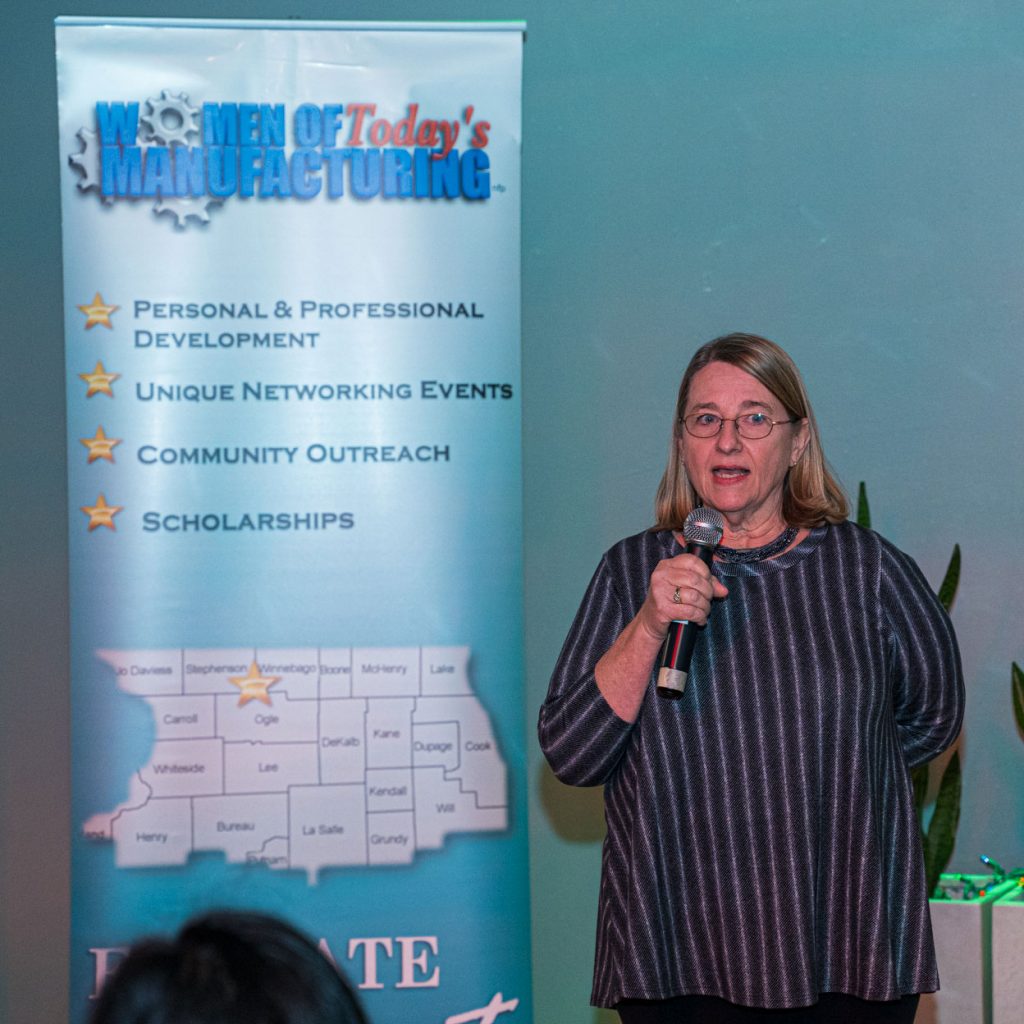
This continues our coverage of manufacturing workforce development in Illinois. Visit our earlier blogs on Illinois’ new apprenticeship legislation and our recent apprenticeship study.
Last month, I stumbled across an organization called Women of Today’s Manufacturing (WOTM). This group provides career pathways for women in manufacturing and scholarships to Rockford-area students pursuing careers in manufacturing and STEM fields. A few emails and LinkedIn messages later, I was on a video call with current president Jaclyn Kolodziej, former president Carrie Zethmayr, and Joie Vittetow, a WOTM member who’s also an engineering student at Northern Illinois University.
What was intended as an informational interview quickly developed into a fluid conversation on barriers to workplace diversity and what steps can be taken to get us closer to gender parity in manufacturing. Below is an excerpt of that conversation.
Can you tell us a bit about Women of Today’s Manufacturing? What do you do?
Carrie: We are a community-based organization that provides support to women in manufacturing. WOTM originated as part of a national organization but the two parted ways in the early aughts. There was a feeling that the national association was spending too much of its resources in DC, that it was becoming out of sync with the needs of the Rockford community. We became a standalone entity and restructured to focus on the needs of our local community.
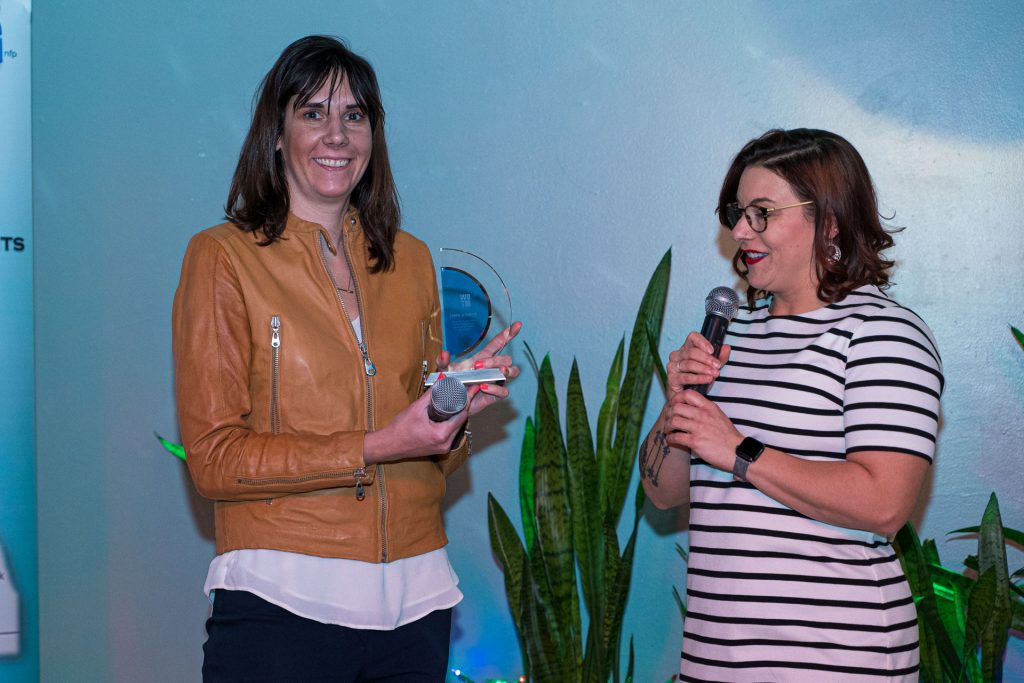
What are your current focuses?
Carrie: We recently re-centered around three strategic initiatives: providing educational programming to our members, scholarships, and building career pathways. We host educational programs to keep leaders and line workers in step with cutting edge trends in the industry and to help our members bring increased value to their employers. We provide scholarships to those seeking to develop their STEM skills. Our career pathways strategy is focused on making connections in the community to help students and under-employed women (and men) enter the manufacturing workforce.
That’s admirable. I also understand your scope goes beyond just supporting young women in manufacturing.
Carrie: That’s correct. In recent years we’ve expanded to include services for adults in career transition or those who are returning to the workforce after a long absence. To clarify, our scholarship program is two-fold; one scholarship is available only to girls, and the second is open to anyone pursuing manufacturing-related higher education. We expanded the offerings to address the needs of our community.
Illinois lawmakers passed a handful of bills last year tasked with strengthening apprenticeship programs across the state. We wrote about that on our blog last month. How can governments better support initiatives to get more women involved in manufacturing? Whose responsibility is it to make this happen?
Jaclyn: It’s great to hear that state legislators are paying more attention to this issue. What I’d suggest they keep in mind is that it’s important to include people who have boots on the ground. We see the issues first-hand and have the ability to give expert advice on what’s best for our communities. It’s been wonderful to see the level of support we’ve gotten from businesses and individuals right here in our community. We’d be grateful to have similar support from local government, as long as it’s informed.
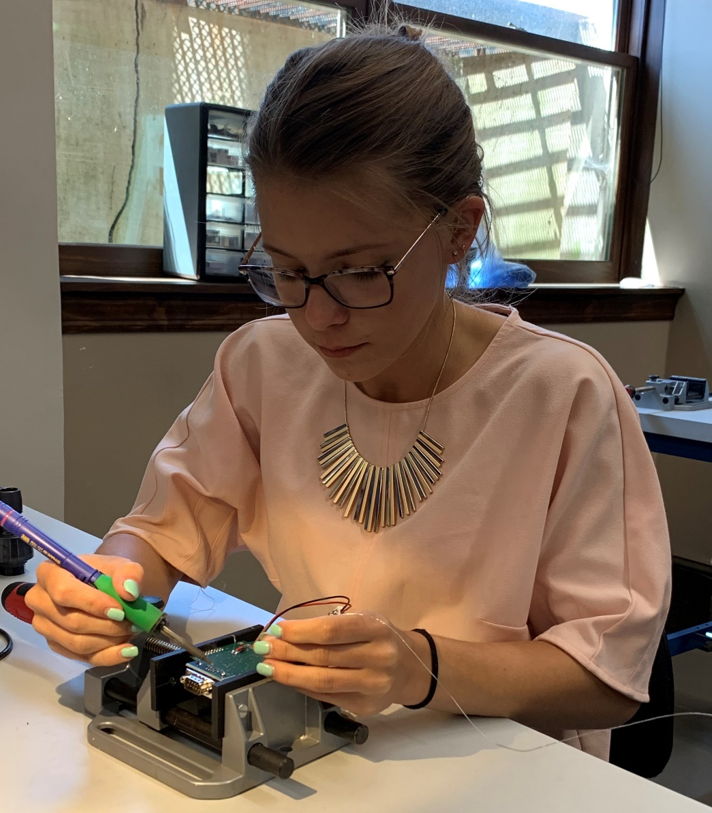
Joie, what has your experience been working in environments that are so male-dominated?
Joie: It’s still a surprise–to most of the men I’ve met–to see a woman, especially a younger woman, in manufacturing. I’ve had guys question whether I’m just there for the money or worse, that I don’t actually know what I’m doing. Without talking to me, they don’t know how passionate I am about this work, or my history in this field. Thanks to my dad introducing me to manufacturing at a young age, I’ve been building things essentially since I was 5 years old. Their facial expressions usually change when they hear that. It means that often times, I have more experience than other men in the shop. Especially the ones around my age.
It has been hard to break into the boys’ club, though. I’m the only girl in my engineering class at NIU, so it can be hard to connect with my classmates. There was one instance where my professor had me come up to the front of the room to work out a problem no one else was able to solve. It was a great experience–despite the fact that I was in sweats that day–and some guys even came up to me afterwards so I could show them again. It was a wonderful chance to bond with my peers, but it seems like there is still some hesitancy for others in the class to interact with me.
Jaclyn: That’s a great point. Because women are so underrepresented in these roles, we need allies. We need other people who understand the value diversity brings to the shop floor. Sometimes that other person is a guy, sometimes it’s a woman who may be higher up in the company. We need others who will help us feel welcome. Getting a seat at the table is an amazing feat, but it can be even harder to have your voice heard once you’re there.
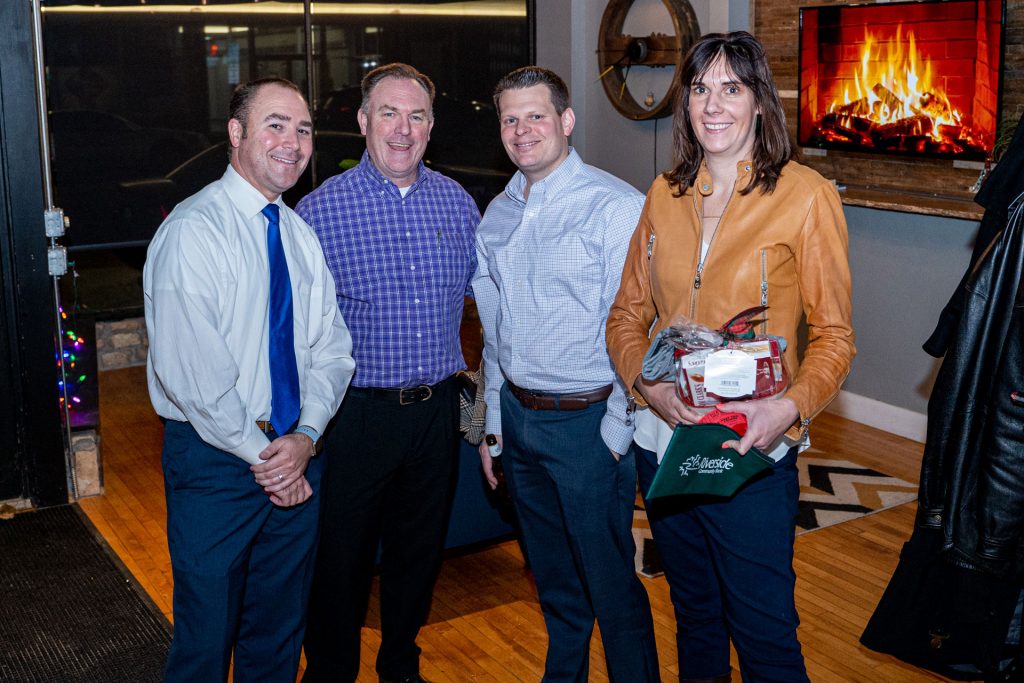
Joie, it sounds like you had years of hand-on experience in manufacturing before you ever stared a training course or entered a classroom. Would you say that’s common?
Joie: Not at all. In fact, that’s one issue I’d take with STEM education today. So much of it is theoretical or math based. Those things are obviously very important, but you need the physical, hands on experience of actually putting things together and seeing how they work. That completes the picture.
Jaclyn: So many people are entering the workforce without that real-life experience. It’s one of the reasons we partner with manufacturers in the area and organize tours. We’ve been a longstanding supporter of FIRST Robotics teams as well. One of our recent accomplishments was investing over $8,000 to support five Rockford-area teams. Early exposure to this field is key.
So, Joie, what are your plans for down the road? How has WOTM played a role in your career development?
I’m currently pursuing my BA in mechanical engineering. After that, I hope to complete an MA in aerospace engineering and have a career designing planes. I want to achieve these goals not just for myself, but to bring other women up with me as well. WOTM opened my eyes to the importance of advocating for women in manufacturing, and I plan to stay involved. Later down the line, I hope to be in a position to inspire other girls to consider careers in manufacturing. It’s a wonderful world to be in.Organizations like these are critical in the push to assure that there is a qualified manufacturing workforce for tomorrow. That means challenging shop owners to recruit in non-traditional ways to find nontraditional candidates. That means introducing youth to this career path at an early age. It also means making sure community associations like WOTM have the necessary resources to ensure women are represented in manufacturing. The responsibility doesn’t fall to any one party–it’s on all of us.
Interested in subscribing to WOTM’s newsletter? Send an email to Jaclyn at wotmrkfd@gmail.com. For additional updates, visit their site and follow them on LinkedIn and Facebook.
Unemployment in the United States has hovered around 3.5% for the past 6 months. Illinois’ own rate hasn’t been too far off at 3.7%. Granted, these numbers are historically low; that’s cause for some optimism. At the same time, their negative implications shouldn’t be ignored. Employers nationwide struggle to find qualified workers. Per a recent publication by the ILO, a growing number of workers find themselves underemployed, having one or more jobs but lacking livable wages. With record low unemployment in the US, a record high number of people are still struggling to make ends meet.
Public and private sector officials have acknowledged issues relating to labor shortages, to a degree. Others have chosen to limit their focus to the benefits of a low unemployment rate, or towards industries that are experiencing explosive job growth. In Illinois, things are shaping up differently. State legislators from both chambers have taken concrete steps to confront skilled-labor shortages. This year, four laws will go into effect that address workforce development through an approach that’s tried-and-true: apprenticeship programs.
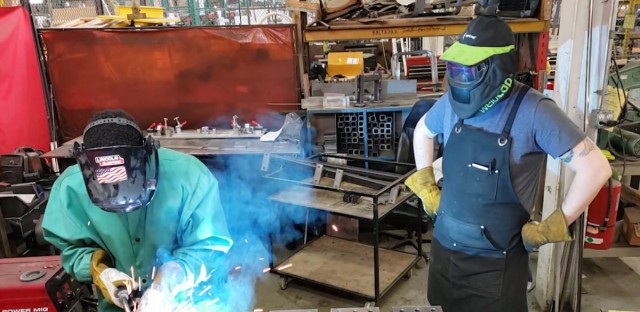
Inside the shop at Freedman Seating.
Photo courtesy of Gabrielle Wright Collins/WBEZ Chicago.
The first is House Bill 2304 which creates the Youth Training and Education in the Building Trades Program. This act covers several bases. Grants established for this program will go to community-based organizations familiar with the building trades. These organizations will deliver hands-on training to youth aged 18 to 35 in their selected trade. Those who complete the training will be eligible for additional education and credentials. The program is geared toward at-risk youth, providing them with the mentorship and professional development that may help them launch their own companies in the building trades. Another noteworthy act, Senate Bill 2024, instructs the Department of Commerce and Economic Opportunity to conduct a study on the potential expansion of apprenticeship programs in the state. Results from this study could have immense benefits for apprenticeship programs not just in the building trades, but in manufacturing and beyond.
Bills like these are excellent indicators that Illinois government officials see the value in apprenticeship programs. This sort of training lays the groundwork so Illinois will have dedicated, qualified employees in emerging generations. Apprenticeships also combat workforce shortages because of the invaluable exposure they give to young workers. Spending time in a real shop is the best way to dispel popular myths that shops are dark, dirty, and dull. Instead, apprenticeships offer a window into the vibrant and innovative workspaces that produce the things we use every single day.
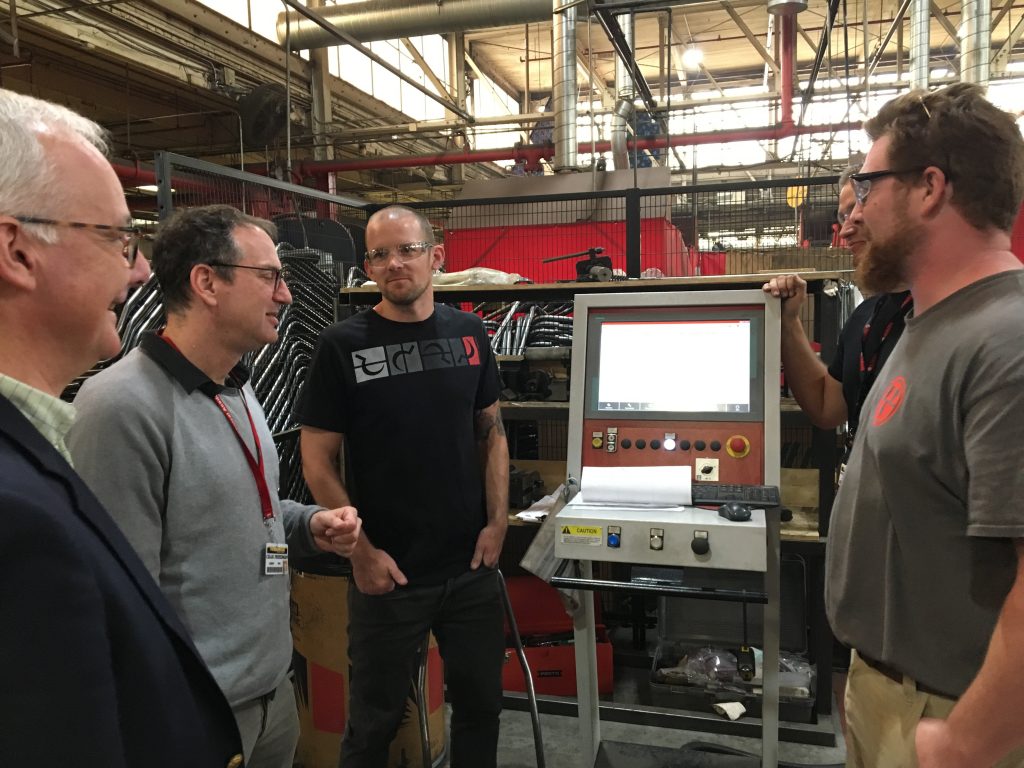
Photo of our team on site at Freedman’s Seating during a workforce development survey in June 2019.
Further, these programs are key in promoting the idea that one can live comfortably with a career in the trades. It’s also promising to see that diversity was in the minds of the bills’ sponsors. Their aim is to ensure that no communities are left out of the benefits these programs will bring to our state. By making these acts into laws, Illinois legislators have demonstrated a commitment to better jobs for all Illinois residents, for today and years to come.
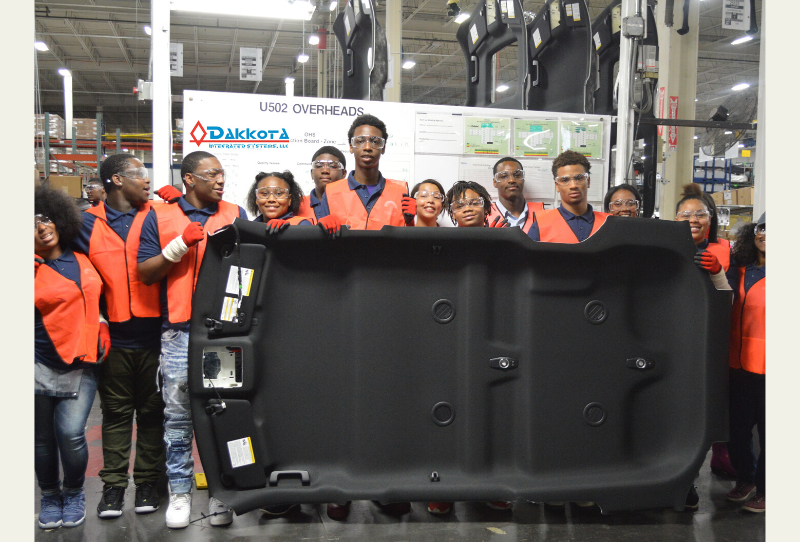
Students on a tour Dakkota Integrated Systems as one of Manufacturing Renaissance’s workforce development initiatives. Header photo is also from one of Manufacturing Renaissance’s programs.
Below, you can find more information on the laws going into effect this year concerning IL expansion of apprenticeship programs:
Bill ID | Text |
Creates the Youth Training and Education in the Building Trades Program with the Department of Human Services and the Illinois Housing Development Authority to train at-risk youth for careers in the building trades. (Martinez) | |
Strengthens support for minority-owned companies, allows some companies to qualify for the Business Enterprise Program if they meet certain municipal-level qualifications, and increase diversity in apprenticeships for construction and the building trades. (Harris) | |
Requires the Department of Commerce and Economic Opportunity to conduct a study on the potential expansion of apprenticeship programs and publish it by June 1, 2020. (Gillespie) | |
Requires Department of Commerce and Economic Opportunity to create a Clean Water Workforce Pipeline Program to prepare people for a career in water infrastructure. (Villivalam) |
View the full list of IL laws going into effect in 2020 (provided by the Illinois Senate Democrats) here or on via the IL General Assembly website.

The Calumet Green Manufacturing Partnership (CGMP) was a life-changing experience for me. Over the span of a few years, I visited over a hundred manufacturers located in the Southland/South Chicagoland. Together we were able to train 176 unemployed people and over 85 of them were hired by more than 30 companies.
We’re excited to announce that we’ve partnered with the Italian Trade Agency and UCIMU to form an exciting initiative similar to CGMP. More than ever, employers want the most qualified workforce—at the best price—in order to keep up with the rapid development of new manufacturing technologies (CNC, robots, automats, IoT, materials, 3D printing, etc.). Sponsored by the leading Italian industry associations, this project is the first step in the development of advanced training programs for new and incumbent manufacturing employees in the US. This is a great opportunity for businesses across the Midwest and their employees.
-Fabrice Bonvoisin, President
Are you a manufacturer using Italian machinery? If so, send us an email at info1@italtradeusa.com to participate in this survey.
Be sure to follow this project on our social media accounts and by searching #ApprenticeshipSurvey.
From motor scooters to shared bikes and ridehailing, city dwellers now have more options than ever before to choose how they get from one point to the next. New mobility providers offer an attractive array of services and have managed to draw in more and more users every year. These new users have come at a cost—one that’s mostly incurred by transit options that were around before companies like Bird and Lime.
In case it bears reiterating, in the US, public transportation ridership is down. Sprawling systems in New York City and DC have been affected by this shift, and in LA, officials are coping with how to service a population that relies so heavily on personal vehicles. Chicago is also feeling the sting. According to CTA’s annual financial report, the end of 2017 saw a 3.17% decrease in rides. In 2016, there was a 3.54% decrease. People are still navigating from place to place within the city, so it’s worth considering why there is a decline in CTA ridership, and whether new mobility services are to blame.
Steve Schlickman, former Executive Director of the Regional Transportation Authority, says the answer is mixed. The RTA oversees the CTA, Metra, and Pace systems, which serve around 8.4 million people in the Chicagoland area. Steve is also former head of the Urban Transportation Center at the University of Illinois at Chicago’s College of Urban Planning and Public Affairs, the fourth largest Urban Planning advanced degree program in the country.

According to him, ridehailing is responsible for some of the drop in ridership as people rely on providers such as Uber and Lyft to get around. That said, ridehailing and other services aren’t completely to blame. Schlickman says that the economy is doing well, and people have more disposable income as a result. This allows them to be selective when choosing how they want to move. He says another possible explanation for the decline in CTA ridership is linked to gas prices. Agreeable gas prices usually account for more vehicles on the road. This is true for personal vehicles as well as rideshare drivers. Fewer people rely solely on public transportation in these conditions.
So, it seems new mobility services are only partly to blame for a dip in transit ridership. Still, their effects shouldn’t be downplayed. Both Uber and Lyft have dramatically increased their driver networks in the last few years, and with Lyft’s recent acquisition of Motivate—the parent company behind Divvy and other bikeshare platforms—further strengthened its reach in the new mobility sphere. Companies like these are expanding, and their growth will likely continue to draw customers towards them, and away from traditional transportation options.

Instead of adopting an adversarial stance against companies like these, however, Schlickman says the CTA’s response has been more collaborative. CTA is working alongside new mobility companies and together they’re trying to address the needs of commuters. The two primary transportation obstacles Chicagoans face are transit deserts and first mile/last mile issues. As the name implies, transit deserts are areas with large populations that are dependent on public transportation and lack adequate access to it. The first mile/last mile problem arises when there is a lack of service during the first and final stretches of a commute. In attempt to combat these issues, Schlickman pointed out that Metra moved forward on a three-year partnership with Uber, naming the rideshare giant its official rideshare partner. As most commuters use a combination of public and private transit options, initiatives like these have the best chance of addressing riders’ needs.

This partnership proved lucrative for both Metra and Uber and will allow the rail company to develop other initiatives. CTA has also been spending in an effort to draw in riders. Despite decreased revenue in both 2017 and 2016, the authority has undertaken several infrastructure projects—the Red-Purple Modernization and the new 95th Street Terminal are just two examples. Schlickman says that although these projects will solve major structural and accessibility issues, they aren’t the only changes CTA is making. It invested in a fleet of electric buses that are set to operate in 2020. Aside from being eco-friendly, they provide a quieter commute; their noise level has been compared to that of an indoor conversation. This emission-less option might be enough to convince some commuters to take the bus as opposed to ordering a Lyft.
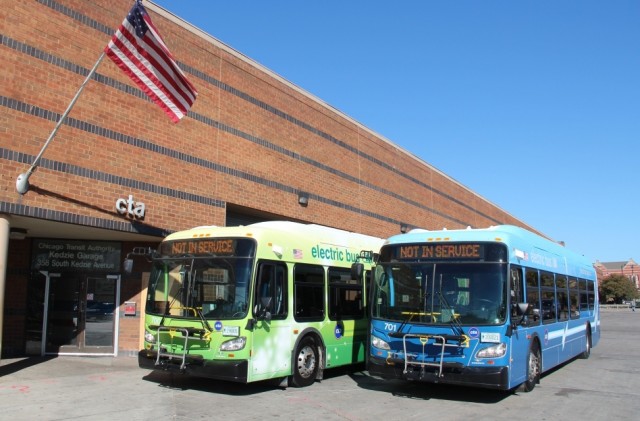
There’s no minimizing the effect micro mobility options will have on public transportation systems in the coming years. In Chicago, the CTA is working with innovative providers to address commuter needs. This, along with greener options, seems the best way forward to ensure the longevity of public transportation networks.
With more people aging out of the workforce than coming in, industries are adopting new strategies to address growing skills gaps. The aviation sector is no different. Last week, we sat down with aviation consultant Ed Glueckler to discuss workforce development in aviation maintenance. Read on for his thoughts on this industry’s labor force woes, and how technology can play a role in bridging the gap.
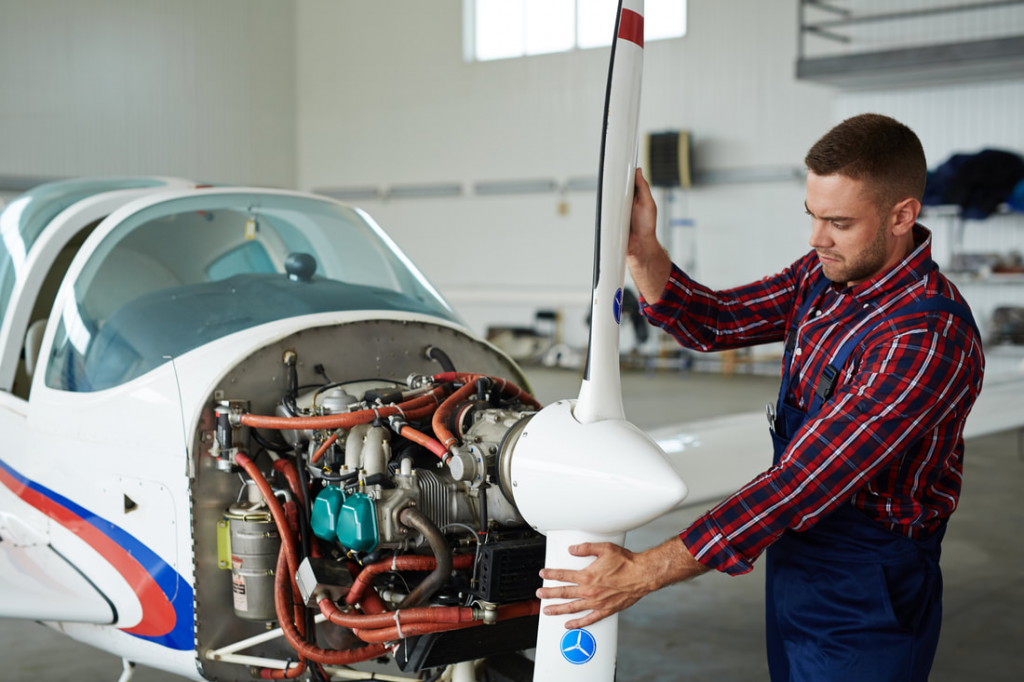
Manufacturers across the country are lamenting a growing skills gap in their industries. In your experience, is a skilled labor shortage also present in the aviation sector? If yes, what do you think contributed to it?
There are two immediate challenges facing the industry that I’ve observed. On one hand, so many seasoned aerospace maintenance technicians are retiring and there aren’t enough younger hires to replace them. Traditionally, the armed forces were principal sources for recruiting aviation technicians. As you can imagine, they gain skills that are easily transferrable to this type of work. Although service men and women typically have the hands-on experience working with the same advanced equipment they’d encounter in this industry, the transition isn’t always so simple. There are still regulatory and compliance tests they have to pass per FAA regulation. The extra regulatory hurdles can seem like a burden to those who wouldn’t have to incur these steps at another job.
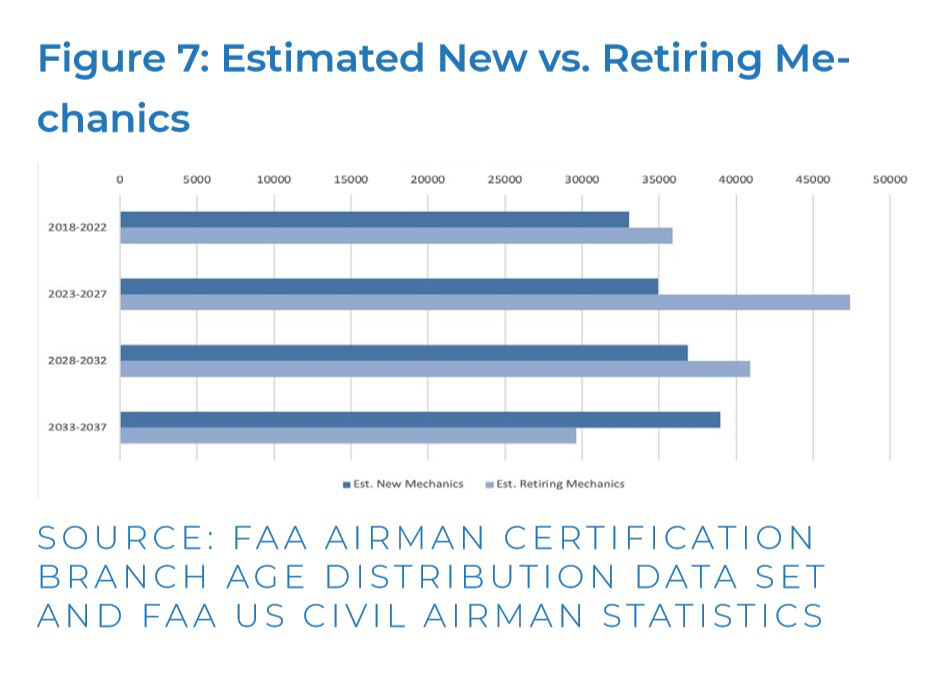
That brings me to my next point. Competing industries have been increasingly successful in recruiting people with the same technical skillsets that are key in aviation maintenance. Theme parks—Disney, for example—have complex hydraulic systems that require operators with skillsets quite similar to those expected of aviation maintenance technicians. An aviation tech may have to work strange hours on the tarmac in unpredictable or unfavorable weather. A place like Disneyland can offer you better hours, compensation, and benefits. Not to mention, it’s the Happiest Place on Earth. When you compare that and the day-to-day work demands at both places, it’s hard for aerospace firms to compete for top talent. The burden falls on the aviation industry to convince someone to choose that path over the more attractive one.
Where else do aviation maintenance firms look for talent?
Aside from the armed forces, these firms primarily look for talent at aviation maintenance vocational schools, but there have been efforts to modernize recruitment. Last year, an aviation workforce development bill was introduced to congress. Proponents of this legislation want to encourage lawmakers to allocate resources for more vocational programs. The bill would also set aside funds for grants, scholarships, and financial assistance for those wanting to learn trade. If passed, it would dramatically contribute to creating a skilled workforce that can support the increasing demand for aerospace technicians.
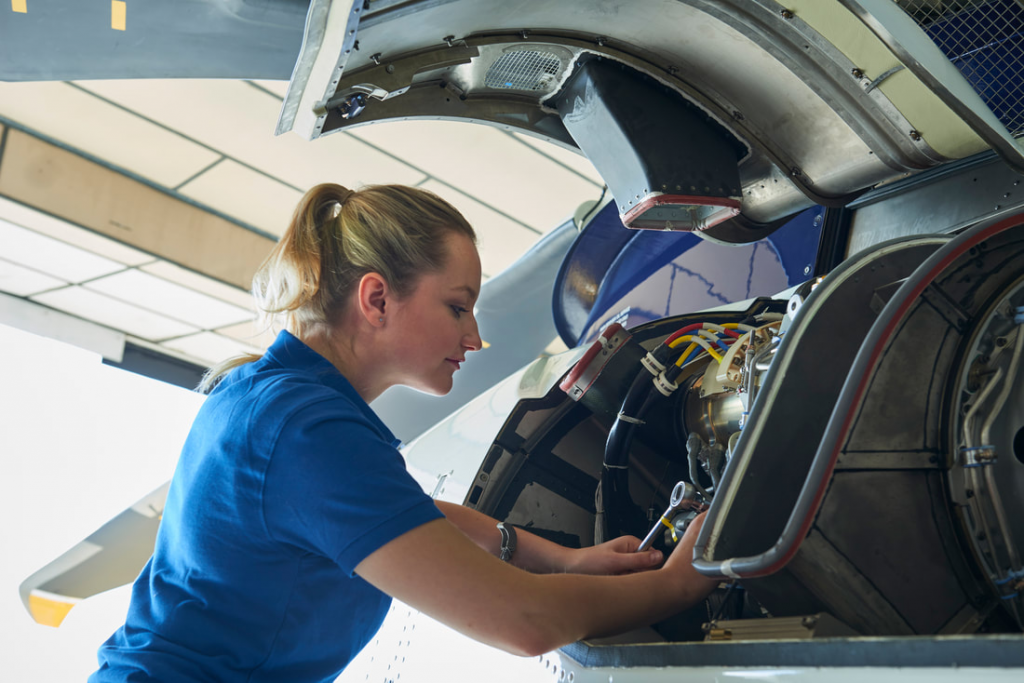
American Airlines (AA) recently came under fire due to a report from the FAA. Whistleblowers from AA’s aviation maintenance teams at O’Hare International Airport allege that they were encouraged by superiors to “not record discrepancies, take short cuts… or improperly sign off on work which was not actually completed.” As of last year, O’Hare surpassed Hartsfield-Jackson in Atlanta to become the busiest airport in America. Do you think that a lack of trained workers, paired with pressure to service an increased number of planes, contributed to decisions to cut corners?
I would say this was unfortunately the work of a few bad apples. My experience with aviation maintenance technicians has led me to characterize them as dedicated, hardworking, and understanding of the importance of their duties. What I can say is that there may sometimes be a difference in the work style of seasoned technicians versus newer hires. Someone who has been working with this equipment for 10-15 years will likely develop an innate sense of it. As a result, they may be able to complete a process in a shorter amount of time than a newer person—perhaps even shorter than time allocated per regulations. Still, I highly doubt the instances you mentioned are due to some encouraging others to cut corners.
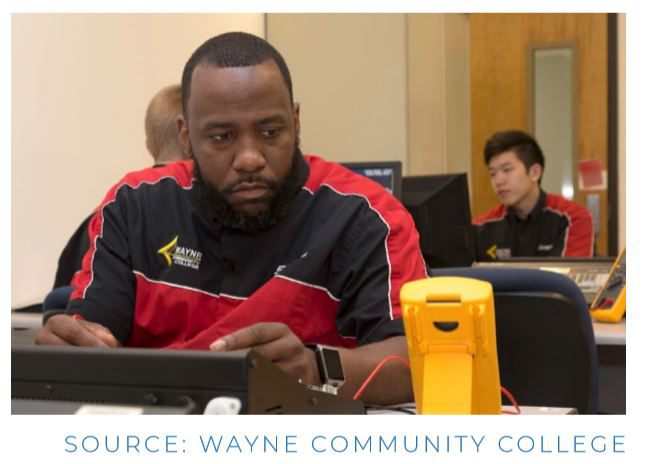
While researching workforce development innovations in manufacturing, I discovered Westminster Tools and Wilbert Plastics, two firms experimenting with cloud technology in employee training. Both companies say that as a result, they’ve been able to minimize skills gaps, cultivate their own workforces, and improve culture at their sites. Could cloud technology be a viable option for aviation firms looking to modernize training?
Absolutely. In the 80s and 90s, if you were working on a piece of equipment, you relied on a paper manual. If you tried a process and got an error code, you’d have to flip through pages and pages to find the code and rectify the issue. Thankfully, over the years the technology has improved and we’re able to extract exactly the information needed in a shorter amount of time. The industry has been able to modernize and compile mass amounts of information on digital systems. These days, if you try something and get an error code, you can rely on an iPad, for instance, that can give you the information you need in seconds.
Technology has been extremely helpful in training as well. You can log hours completing technical training via digital simulations. The idea now is that the first time you touch an engine or a piece of equipment, you already have some familiarity with it, thanks to the technology you used in training.
What do you see as the top innovations that will impact the aviation industry in 2019? How might these affect the workforce?
The use of augmented reality and virtual reality software has been especially helpful in training as well. As I alluded to earlier, technicians-in-training use applications to virtually complete maintenance tasks and gain experience with equipment before even physically touching it. Developments in this arena have made a huge impact.
At the same time, the technological innovations worth mentioning in this sector go beyond those limited to training. Thanks to advanced engineering, we’re also seeing new aircraft that requires fewer service appointments. Similar to the way that cars can indicate to owners which parts might need immediate attention, more planes are being developed with intelligent maintenance information systems.
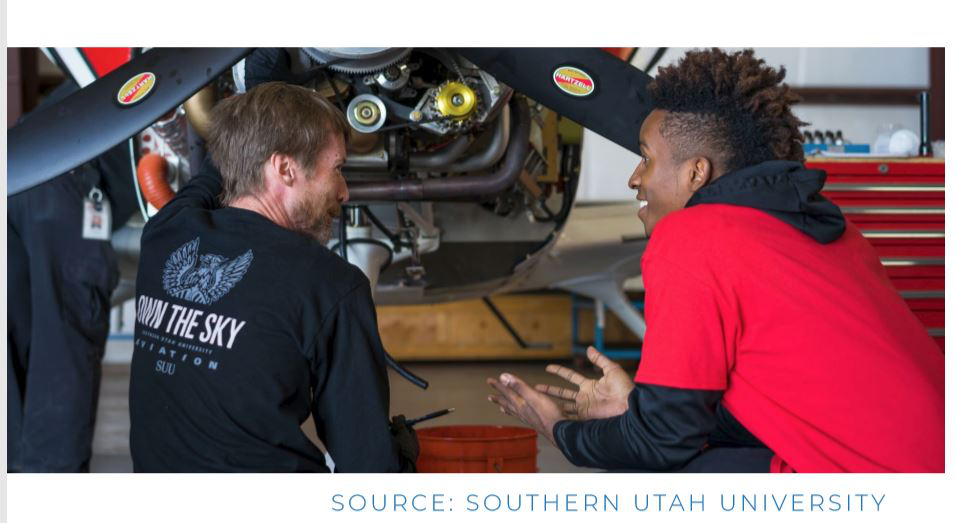
Another trend I’ve noticed is that some of the technical maintenance work in this industry is now being outsourced. Whereas Delta or United may have previously done work on a specific part of a plane in house, they might now employ a smaller firm that specializes in that kind of maintenance. An increase in 3rd party providers in the market can in turn grow the industry by creating job opportunities.
All in all, improved technology and increased access to it via training has already set things off to a great start. This is a high-paying industry that’s quietly expanding, though at an increasing rate. To support demand, we’ll need to keep enhancing tech and keep developing initiatives that will create more skilled aviation maintenance technicians.
Upcoming events you may be interested in attending:
Feb. 19: Harnessing the Dragon: Latest Developments Regarding Arbitration in Hong Kong and Mainland China. Webinar, sponsored by Winston & Strawn, will explore the latest developments regarding arbitration in Hong Kong and in Mainland China, including a case handed down by the Court of Final Appeal and a decision of the Indian Court dealing with the split of the China International Economic and Trade Arbitration Commission, which may have an impact on the enforcement of CIETAC arbitral awards in other jurisdictions. 11:00am –12:00pm CST. No charge; advance registration required.
Feb. 21: Beauty and Cosmetics Opportunities in India. Webinar, sponsored by the U.S. Commercial Service, will describe the growing opportunities for beauty and cosmetics products in India and how U.S. companies can effectively enter the market. 9:30am CST. No charge; advance registration required.
Learn more about how we can make your
market development a success, in the U.S. or in another country.